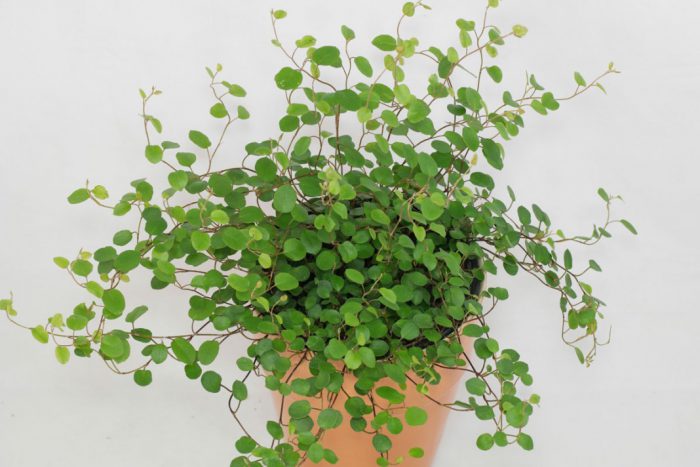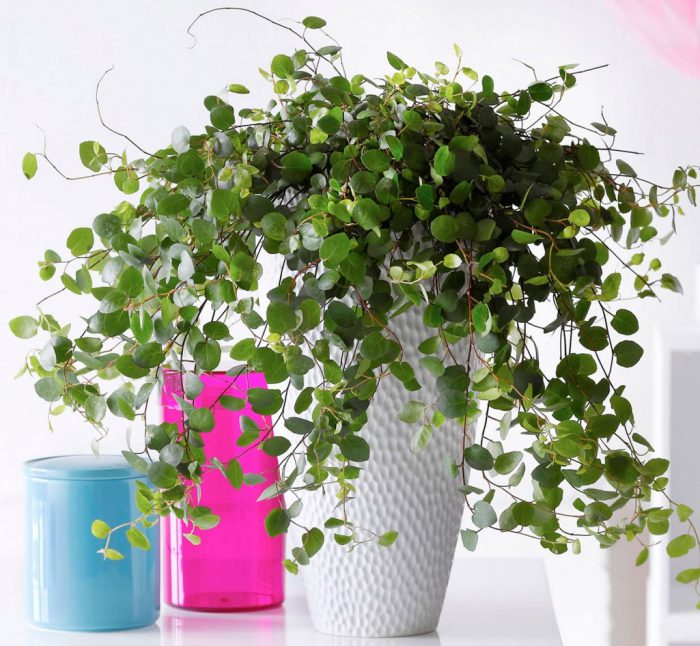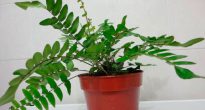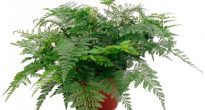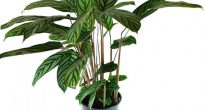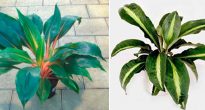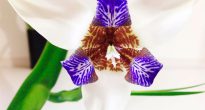Kind of like muhlenbeckia (Muehlenbeckia) is directly related to the buckwheat family (Polygonaceae). It unites about 20 species of various climbing or creeping dwarf shrubs and shrubs that are evergreen. They are found naturally in New Zealand and Australia.
Strongly branching, lignified, thin stems intertwine with each other. The most compact species have shoots no more than 15 centimeters long, and the largest ones have up to 300 centimeters. The smooth bark is brown or brown-red in color. Small alternate leaves, which are short-petiolate, have the shape of an oval or wedge-shaped, as well as obovate. And there are species whose leaves have a heart-shaped base. Axillary, few-flowered inflorescences are collected in a brush. Tiny (half a centimeter in diameter) five-petal flowers of greenish-yellow or white color do not represent decorative value. The fruit is presented as a spherical achene.
Despite the large number of species, in home floriculture, as a rule, only one is used - Muehlenbeckia complexa covering or confused. Its tiny (0.6 to 1.5 centimeters in diameter) oval-shaped leaves are painted in a dark green color, and they shine red along the edges and along the veins.
There are several varieties of such a plant, the differences of which are in the size of the leaves:
- "Large-leaved" (Grandifolia) - the leaf is larger than that of the natural species;
- "Microphylla" - average leaf size;
- "Nana" (Nana) - the smallest leaves.
Content
Home care for muhlenbeckia
This plant can be easily grown by novice flower growers. It is very unpretentious and not demanding to care for. Mühlenbeckia is often grown as a liana, fixing it on a special support or as an ampelous plant in hanging pots.
Illumination
The plant is light-requiring and therefore needs a well-lit place. But it should be borne in mind that it is better if the light is diffused. He needs a certain amount of direct rays of the sun in the evening or in the morning. It is recommended to place a flower in the western or eastern part of the room. If you put the flower on the north side, then the stems will be very elongated and thin, since there is little light there. In the southern part of the premises in the summer at noon hours, it is necessary to provide the plant with shading.
Temperature regime
In the warm season, the plant needs a moderate temperature.So, it will feel great at temperatures from 22 to 24 degrees. If it gets hotter, the leaves will become lethargic and begin to turn yellow.
In winter, a cool content is recommended for Mühlenbeckia. So, it must be kept at this time in a place with a temperature within 10-12 degrees. At this time, a dormant period is observed and the plant often sheds a certain number of leaves.
How to water
During intensive growth, the plant should be watered so that the substrate in the flower pot is constantly slightly moistened. At the same time, you need to remember that in no case should water stagnation in the ground be allowed. The result of this can be soil acidification, as well as the formation of rot on the flower, which will lead to its death.
Water less during the dormant period. So, between watering, the top layer of the substrate should dry out well.
Watered exclusively with settled, soft water at room temperature.
Humidity
There are no special requirements for air humidity. In the case when the room temperature is very high (in summer), it is recommended to spray the leaves with lukewarm water.
Earth mix
The soil suitable for the plant should be slightly alkaline or acidic. The most important thing is that the soil should be loose, and also moisture and air permeable. You can make a soil mixture with your own hands, for this by mixing sheet, clay-sod and peat soil, as well as coarse sand, taken in equal proportions. You can also purchase a versatile soil for indoor deciduous plants.
Do not forget to make a good drainage layer at the bottom of the container, consisting of pebbles or expanded clay. This will prevent waterlogging of the earth and the formation of rot.
Top dressing
Muhlenbeckia is fed during intensive growth 2 times a month. For this, a complex fertilizer for indoor deciduous plants is suitable. With the onset of autumn and until mid-spring, feeding should be stopped.
Transplant features
The transplant is carried out once a year in the spring. The plant should be transplanted very carefully, since it is sick for a long time due to damage to the root system. It is recommended to transfer the flower along with a lump of earth into a larger container.
Reproduction methods
You can propagate it by dividing the bush during transplantation, by seeds, as well as ripe cuttings. For cuttings, the tops of the stems grown this year in the last summer weeks are trimmed. The length of the cuttings should be 8-10 centimeters, and they are rooted in a glass of water, sand, perlite or light soil. In all cases, except for water, you will need a well-lit mini-greenhouse (no heating needed). To make the bush thicker, it is recommended to plant several cuttings in one container.
Seeds are sown from March to April. They are not buried in the soil, but simply scattered over its surface. Then you should put the bowl in a mini-greenhouse.
Pests and diseases
Muhlenbeckia practically does not get sick and is not affected by pests. But it can be harmed by waterlogging or overdrying of the soil, direct rays of the sun, high or low temperatures, poor lighting, and so on.

